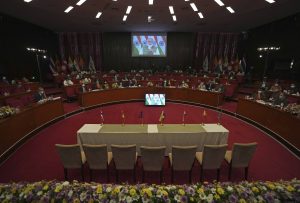The past few months have seen a focus on relatively newer minilateral mechanisms, including the U.S.-Japan-Philippines trilateral and the Australia-U.K.-U.S. (AUKUS) security pact. Yet this narrower focus belies the broader trend of minilateral networking across countries and sectors, which transcends both the recent efforts by Washington and the emphasis on the security sphere. It also skirts the question of the range of opportunities and challenges these minilaterals present as well as how they may play out in the future.
Asia is no stranger to minilateralism. Definitional parsing aside, in practice minilateral-type institutions grouping a few key states have been part of the region’s evolving institutional architecture for decades, be it the Malacca Straits Patrols agreement between Indonesia, Malaysia, Singapore, and Thailand or the Bay of Bengal Initiative for Multi-Sectoral Technical and Economic Cooperation (BIMSTEC), comprising Bangladesh, Bhutan, India, Myanmar, Nepal, Sri Lanka, and Thailand, which was set up in 1997 amid the post-Cold War focus on regional integration. They have also coexisted amid other parts of the regional architecture amid broader shifts, including multilateral institutions like the Association of Southeast Asian Nations (ASEAN) and the network of five U.S. bilateral alliances with Australia, Japan, the Philippines, South Korea, and Thailand.
This latest phase of minilateral proliferation is striking in terms of its multi-actor and multifaceted nature. U.S.-driven minilaterals, such as AUKUS or the U.S.-Japan-South Korea trilateral, often get the most attention amid the growing focus on U.S.-China competition. But this ignores the broader story that Asian countries themselves have utilized minilaterals to confront a wide array of challenges stemming from what some have called a polycrisis. Examples include India’s cultivation of non-U.S. minilaterals like the Australia-India-Indonesia trilateral or Singapore and New Zealand’s founding involvement in the Digital Economy Partnership Agreement, which is a more sectoral minilateral. Relatively narrower issue-based, cross-continental examples include the Italy-Japan-U.K. Global Combat Air Program.
Additionally, while China protests the formation of some minilaterals as efforts to contain it, Beijing is developing institutions of its own. Some of these are sparking their own share of concerns in parts of the region, though these are at times raised more quietly. One prominent example is the inroads China has tried to make through its Lancang-Mekong Cooperation framework in mainland Southeast Asia. At the same time, other institutions with China as a leading player are also gaining traction among some states. The growing list of countries signing on for the expansion of the BRICS – named after its original members Brazil, Russia, India, China, and South Africa – is a case in point, amid concerns in some circles about growing Sino-Russian collaboration. This extends out to more targeted examples as well, including Beijing’s attempted inroads into the space domain via the International Lunar Research Station outside of U.S.-led initiatives like the Artemis Accords.
This proliferation of minilaterals brings a mix of opportunities and challenges for the regional architecture. Minilaterals are attractive because they can take speedier action than multilaterals and are more flexible than alliances. At the same time, their looser nature can sometimes make them harder to institutionalize and sustain amid changing leaderships, as evidenced by the Quad’s early experience. Minilaterals can also raise questions about how they undermine aspects of the existing architecture, duplicate existing functions, and complicate norms around transparency and inclusivity in the context of intensifying major power competition. The most visible manifestation of this is worries about ASEAN centrality, even though some prominent former officials have themselves pointed out that this is in part due to the grouping’s inability to act on previous initiatives to get ahead of evolving strategic dynamics.
Navigating these opportunities and challenges will require a focus not just on assessing these institutions from a wider value-based cost-benefit perspective, but also on acknowledging the complex and real tradeoffs at play between aspects like inclusivity and efficiency. And while a more strategically competitive environment makes it even more difficult to agree on a common set of norms and practices around institution-building, basic attention to aspects such as socializing new institutions relative to existing ones and doing so in a transparent way will be key to managing evolving dynamics. Additionally, issues such as cross-institutional linkages should be considered not just in the aggregate, but also in a more flexible, ad-hoc and issue-based fashion. After all, this is one of the advantages that minilaterals are supposed to enjoy relative to larger and more rigid multilateral institutions. We should also expect to see more countries engaging in forms of institutional hedging and forum shopping which may defy neat conceptions of where countries fit in U.S.-China competition or Indo-Pacific architecture.
The exact trajectory of this latest wave of minilateralism in Asia remains to be seen. The hope is that new minilaterals can help meaningfully address the manifold challenges experienced by regional governments and their people, from maritime coercion to the climate crisis. At their best, they may even reenergize multilaterals and demonstrate that institution-building need not always be a zero-sum game. At the same time, if efforts are not made to properly resource and sustain these minilaterals, they could also end up further complicating Asia’s already messy institutional landscape while providing little additional value. Worse, they could become platforms that entrench bipolar divisions, as some policymakers have warned, especially if institution-building is narrowly focused around U.S.-China oneupmanship and this impulse is not moderated by other influential powers like Australia, the European Union, India, Japan, or South Korea.
The exact path that Asia’s new minilateral wave will take in the coming years remains to be seen. Yet the complexity of the challenges that exist before us and the hunger for greater collaboration and tangible results suggests that the focus on this layer in Asia’s multilayered institutional landscape looks set to continue in the years to come.

































